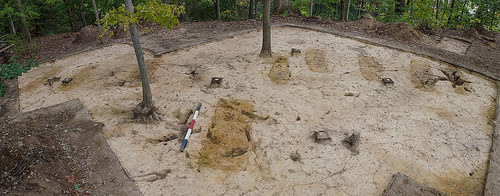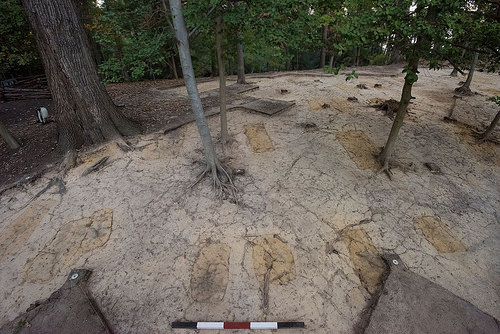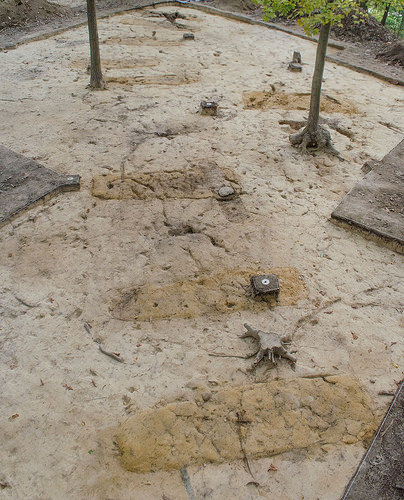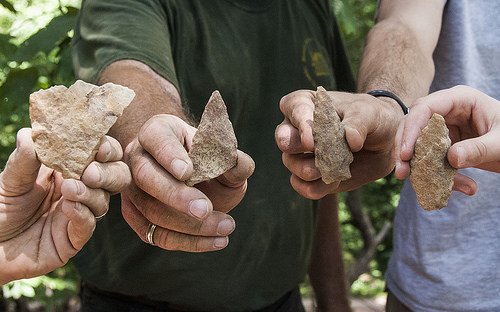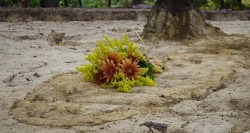
Anyone visiting George Washington’s Mount Vernon Estate today will see a large, ornately designed red brick enclosure only a brief southward walk down-slope from his restored mansion house. It defines the entrance to the tomb vault wherein lies the marble sarcophagus containing the remains of George Washington himself. Inlaid at the top of the enclosure is a stone tablet with the inscribed legend, “Within this Enclosure Rest the remains of Gen.l George Washington.” It is among the most visited stations on the Mount Vernon property, and on any given day during peek visitation times of the year there are typically long lines of visitors before the tomb, anxious to snatch a glimpse and snap pictures of the very place where Washington rests. Like a pilgrimage destination, it is, historically speaking, sacred ground for the thousands of American travelers who come to this place each year.
But only yards south from the tomb is a nondescript patch of ground, populated by a few trees and other unremarkable vegetation. There are no signs or anything that bespeaks a memory in this little place. But here, beneath the surface, lie the remains of a slave. Archaeologists happened upon it while conducting a survey.
A few steps further to the west of this spot, along a narrow, forested ridge, lie the remains of many more slaves. There are no individual markers, no tombstones — and for many decades, there hasn’t been a single surface trace of a burial, other than a single, albeit well-appointed, memorial created by the Mount Vernon Ladies Association to memorialize the ground as a slave cemetery. “In Memory of the Afro-americans who served as slaves at Mount Vernon……” reads the legend in stone on the memorial.
Joe Downer, who is an archaeologist with Mount Vernon’s archaeology program, leads me down across the ridge. As the archaeological crew chief for the team assigned to conduct a survey of the cemetery, he is now in his third season of excavations at the site. “In 1985,” he says, “GPR surveys detected subsurface anomalies that were interpreted to be possible grave shafts. In the early 90’s, we dug shovel test pits in the area and found three burials. That was followed much later from 2007 to 2012 with a small-scale investigation and then full-scale excavations beginning in 2014.”
“We have always known that there was an area used as a slave cemetery,” added Downer. Historical documentation for this, however scant, hinted that this had to be the case. Although Washington never mentioned a slave cemetery on his property during his lifetime, historians do know that during the 1790’s carpenter slaves were building coffins for their fellow deceased slaves, and they know the names of a few of the slaves thought to be buried at Mount Vernon, including Frank Lee, Washington’s butler, his brother William (Billy) Lee, who was with Washington as his servant throughout the Revolutionary War, and West Ford, a slave who served the Washington family, freed in 1829 but serving the family until he died in 1863. Caroline Moore, a visitor to Mount Vernon in 1833, writes of seeing a slave burial ground: “Our guide first took us to the tomb where the remains of General Washington are now interred…….Near his Tomb, you see the burying place of his slaves, containing 150 graves.” And another Mount Vernon visitor account recorded in 1846 mentioned that there were “many [servant/slave] graves in the grove”. A historical map printed by Charles Currier in 1855 indicates a “Negro Burying Ground” with 12 graves within a fenced plot.
But despite the clues of a slave cemetery at Mount Vernon, its traces were for the most part lost in time and forest overgrowth, until the archaeology department of the Mount Vernon Ladies Association began the investigations. Today, after two complete seasons of 5’ by 5’ test excavation units, one can see the visible outlines of the tops of at least 47 grave shafts. They are distinguishable by clear yellowish, rectangular ‘shadows’ in an otherwise pale, light-brown silty clay soil context. The archaeologists have no plans to excavate into the grave shafts further to investigate the remains of the interred. “Ethically, it would be frowned upon to excavate the remains strictly for the purpose of research,” says Downer.
For now, a forensic examination of the remains of the interred to identify specifically who among Washington’s slaves were buried in the cemetery and, more feasibly, the physical conditions, diseases, gender, age, and physical builds of the interred, will remain elusive. Current objectives are confined to determining the boundaries of the cemetery and the spacial relationships and number of shaft graves, with the ultimate goal of producing an accurate, complete map of the cemetery. In the process, they will be recovering any artifacts at the top of the graves, though they are sparse. Test units have thus far indicated that the burials were restricted to the top, level area of the ridge, and one other pattern has become clearly evident as they have excavated: “All the burials are oriented east/west,” says Downer.
“Overall, these burials are fairly typical of other slave burials on other plantations,” he adds. More significantly, he says, this particular survey/excavation is “the first of its kind” and should inform planners in the future about how to manage the property in this area of Washington’s estate in addition to contributing to a better knowledge of the Mount Vernon landscape. But most of all, for Downer and the team working at the site, it is an exciting opportunity to uncover a little bit of material history that otherwise would have continued to languish in oblivion.
Concludes Downer: “It’s very powerful to see where these [long-forgotten] people were buried.”
________________________________________
Who are they? What are their names? Above and below, the exposed individual grave shaft locations as revealed through excavation. Courtesy George Washington’s Mount Vernon
_____________________________________________________
Beyond the traces of grave shafts, “we continue to find numerous prehistoric artifacts in the Slave Cemetery that speak to the Native American occupation of the site,” says Downer. Above photo illustrates the kinds of prehistoric artifacts that are being unearthed at the site, including lithics dated to the Late Archaic period (5000 – 3000 BP). They testify to human occupation of the site long before the Washington family ever acquired the property for their plantation. Courtesy George Washington’s Mount Vernon
_____________________________________________________
Individuals interested in learning more and following the progress of the slave cemetery survey can obtain more information from the website, and individuals interested in participating in this project as volunteers with the archaeology program at Mount Vernon may learn more about the opportunities at this page.
_____________________________________________________
Image, second from top, right: The Tomb of George Washington. Ken Lund, Wikimedia Commons
Cover photo: An exposed outline of a slave grave shaft with a bouquet of flowers placed upon it. Courtesy George Washington’s Mount Vernon
_____________________________________________________

